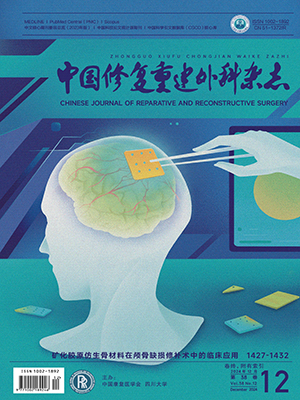Objective To study the outcomes of nerve defect repair with the tissue engineered nerve, which is composed of the complex of SCs, 30% ECM gel, bFGF-PLGA sustained release microspheres, PLGA microfilaments and permeable poly (D, L-lacitic acid) (PDLLA) catheters. Methods SCs were cultured and purified from the sciatic nerves of 1-day-old neonatal SD rats. The 1st passage cells were compounded with bFGF-PLGA sustained release microspheres and
ECM gel, and then were injected into permeable PDLLA catheters with PLGA microfilaments inside. In this way, the tissue
engineered nerve was constructed. Sixty SD rats were included. The model of 15-mm sciatic nerve defects was made, and then the rats were randomly divided into 5 groups, with 12 rats in each. In group A, autograft was adopted. In group B, the blank PDLLA catheters with PBS inside were used. In group C, PDLLA catheters, with PLGA microfilaments and 30% ECM gel inside, were used. In group D, PDLLA catheters, with PLGA microfilaments, SCs and 30% ECM gel inside, were used. In group E, the tissue engineered nerve was appl ied. After the operation, observation was made for general conditions of the rats. The sciatic function index (SFI) analysis was performed at 12, 16, 20 and 24 weeks after the operation, respectively. Eelectrophysiological detection and histological observation were performed at 12 and 24 weeks after the operation, respectively. Results All rats survived to the end of the experiment. At 12 and 16 weeks after the operation, group E was significantly different from group B in SFI (P lt; 0.05). At 20 and 24 weeks after the operation, group E was significantly different from groups B and C in SFI (P lt; 0.05). At 12 weeks after the operation, electrophysiological detection showed nerve conduct velocity (NCV) of group E was bigger than that of groups B and C (P lt; 0.05), and compound ampl itude (AMP) as well as action potential area (AREA) of group E were bigger than those of groups B, C and D (P lt; 0.05). At 24 weeks after the operation, NCV, AMP and AREA of group E were bigger than those of groups B and C (P lt; 0.05). At 12 weeks after the operation, histological observation showed the area of regenerated nerves and the number of myel inated fibers in group E were significantly differents from those in groups A, B and C (P lt; 0.05). The density and diameter of myel inated fibers in group E were smaller than those in group A (P lt; 0.05), but bigger than those in groups B, C and D (P lt; 0.05). At 24 weeks after the operation, the area of regenerative nerves in group E is bigger than those in group B (P lt; 0.05); the number of myel inated fibers in group E was significantly different from those in groups A, B, C (P lt; 0.05); and the density and diameter of myel inated fibers in group E were bigger than those in groups B and C (P lt; 0.05). Conclusion The tissue engineered nerve with the complex of SCs, ECM gel, bFGF-PLGA sustained release microspheres, PLGA microfilaments and permeables PDLLA catheters promote nerve regeneration and has similar effect to autograft in repair of nerve defects.
Citation: WANG Guanglin,LIN Wei,GAO Weiqiang,XIAO Yuhua,DONG Changchao. CONSTRUCTION AND EVALUATION OF THE TISSUE ENGINEERED NERVE OF bFGF-PLGA SUSTAINED RELEASE MICROSPHERES. Chinese Journal of Reparative and Reconstructive Surgery, 2008, 22(12): 1485-1490. doi: Copy
Copyright © the editorial department of Chinese Journal of Reparative and Reconstructive Surgery of West China Medical Publisher. All rights reserved




